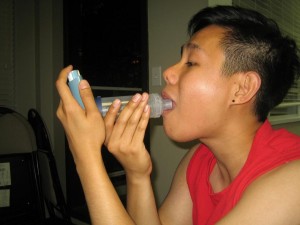When an individual with asthma makes contact with something that aggravates their airways (a trigger), the muscle surrounding the walls of the airways constrict so that the airways become narrow and the inside layer of the airways become swollen and start to bloat. Occasionally sticky mucus builds up which can also constrict the airways.
Asthmatics usually use two types of inhalers to administer and assist the condition. A brown inhaler includes a precautionary medicine and a bluish inhaler contains a reliever medicine. Asthmatics generally only call for help when they have taken their medication and it doesn’t seem to help.
Symptoms of Asthma
- A dehydrated, sterile cough
- Trouble in breathing – particularly exhaling
- Out of breath
- Tension of the chest
- Trouble talking
- Pain and nervousness
- Potential loss of consciousness

Assisting a Casualty with Asthma
- Any management should be intended at lessening the casualty’s inhalation and calling for help if necessary.
- Relax and assure the casualty whilst sitting them down, preferably leaning a little forward.
- Persuade the casualty to use their inhaler as directed.
- Medication should ease the warning signs of the attack within a couple of minutes. If there is no success, assist them to use their inhaler again every 5-10 minutes.
- Observe their vital signs (breathing and pulse).
Calling the Paramedics
- If the inhaler is not working after 5 minutes
- If the situation is getting worse
- If speaking is becoming more complicated
- If they begin to become fatigued
- If you are at all uncertain
Assisting a Casualty without an Inhaler
Trying to assist an individual struggling through an asthma attack with no inhaler can be a terrifying occurrence, but the most vital thing you can do to assist is to remain unruffled. Aside from breathing gradually, staying composed is vital for the casualty suffering an asthma attack and you don’t want to add to the anxiety they are experiencing. Seeing you tranquil and calm can also assist the casualty to stay calm, which will permit more air to go through their airways.
- Call the paramedics and a close family member who has access to an inhaler. Calling the paramedics is also vital in case you are not capable of getting the casualty’s breathing under control.
- Train the casualty to inhale through the nose and out through the mouth gradually and consistently as possible. Massage their back to help the casualty calm down. The plan here is to evade pulling for air too rapidly, which can cause the chest to become tighter.
- Assist the individual find and use the inhaler. The medicine will aid the casualty to rest the airways.
- Let the casualty sit down. Lying down isn’t suggested as this position can cause more strain on the lungs.
